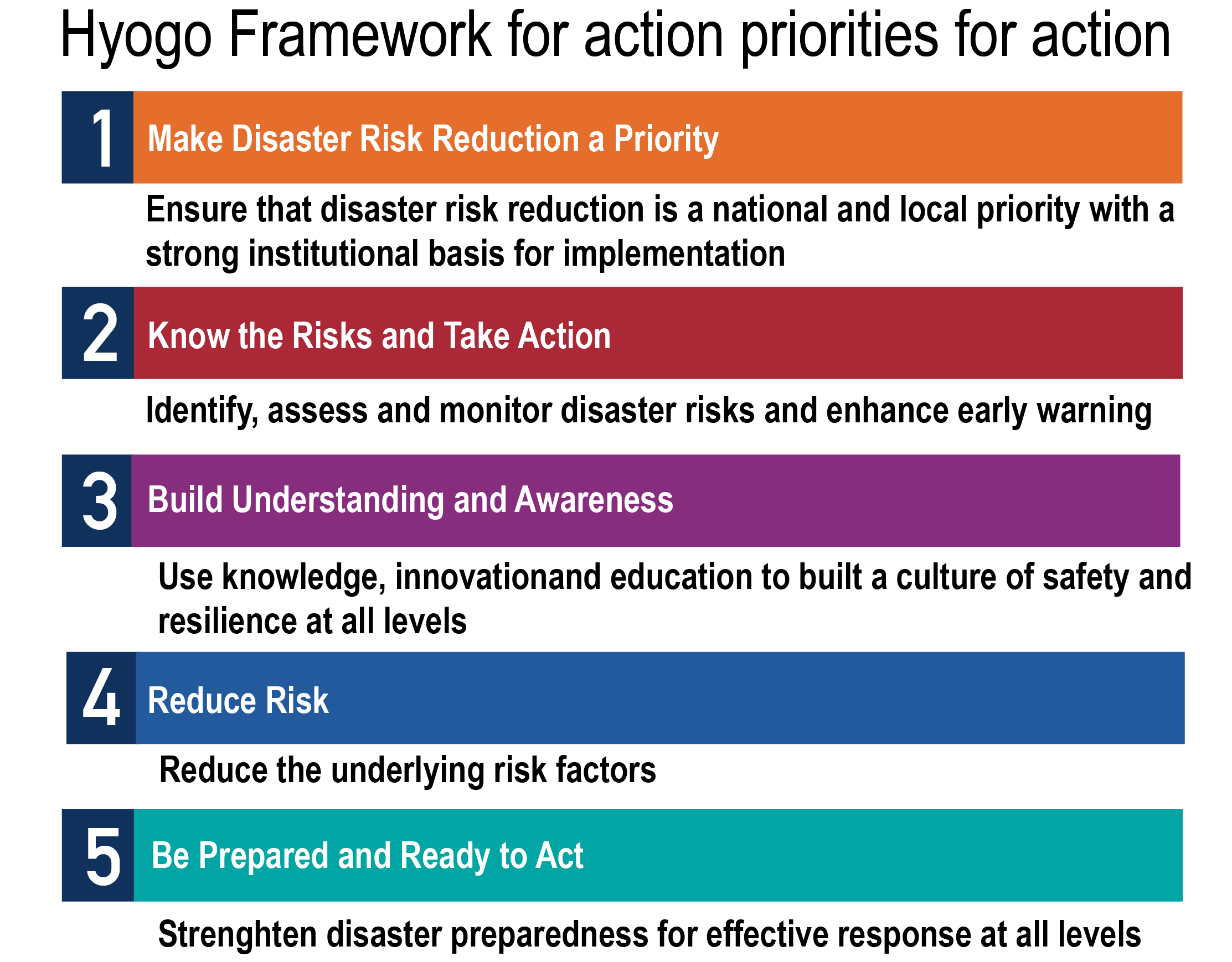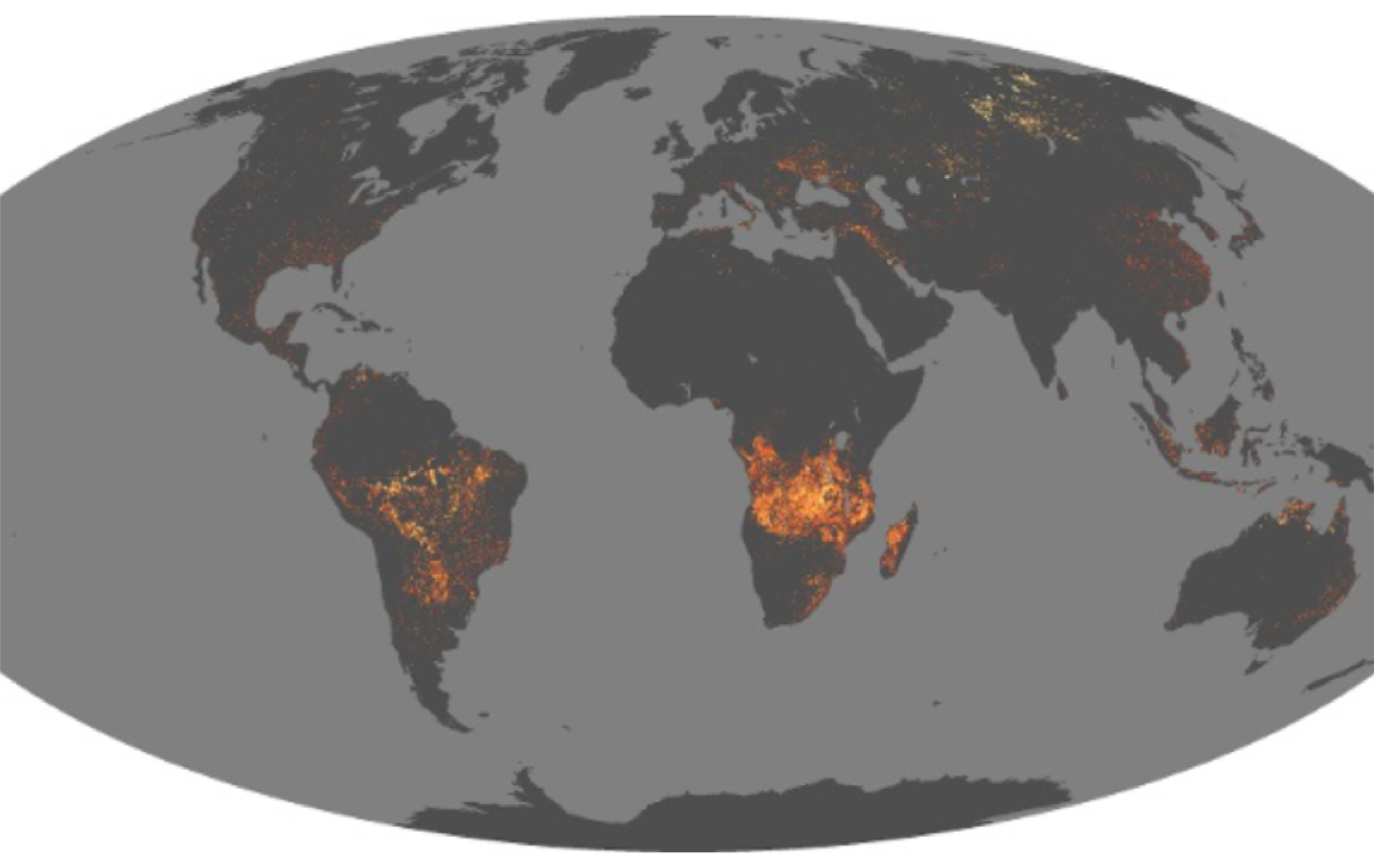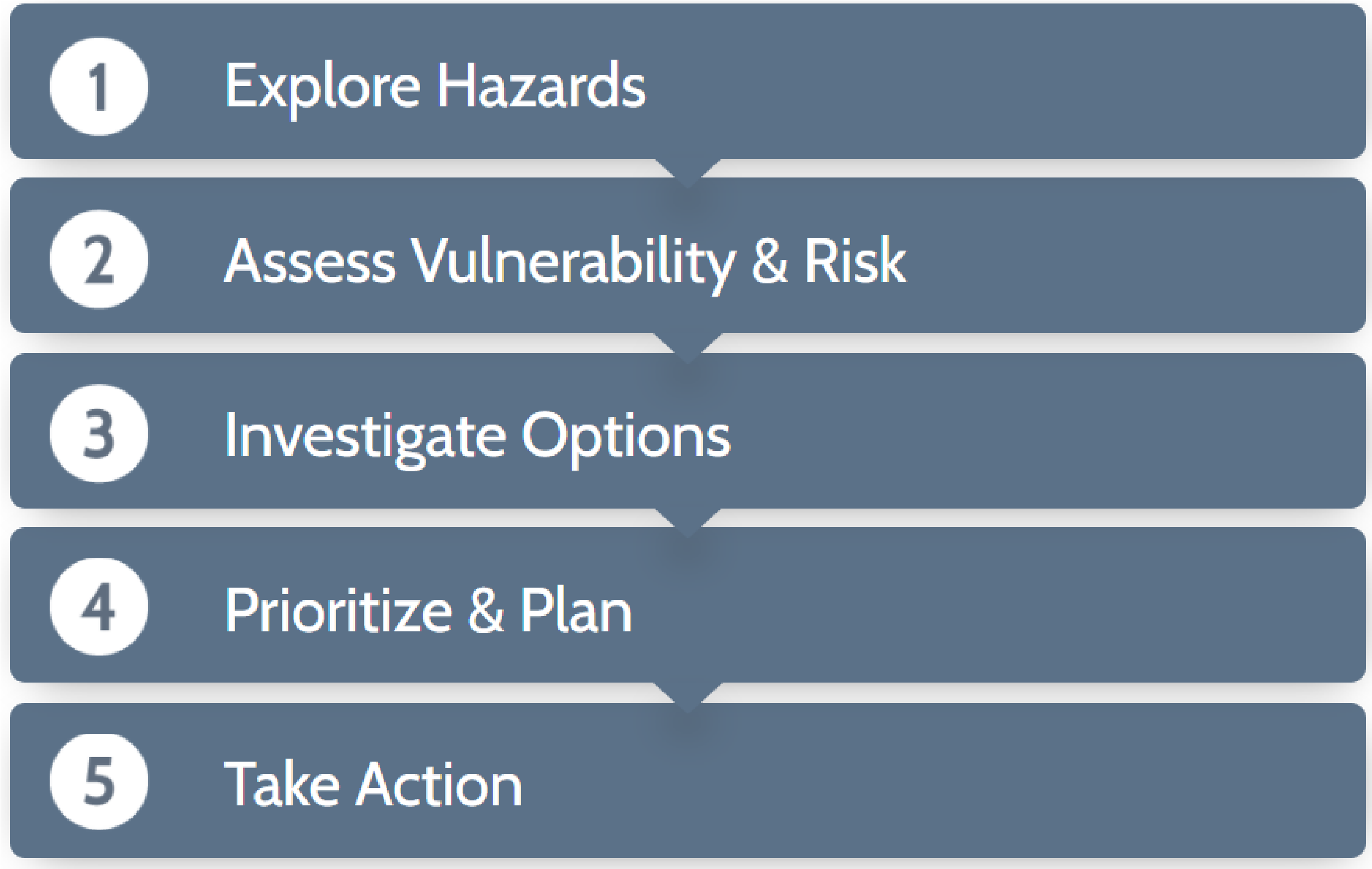

At the World Conference on Disaster Reduction held during January of 2005 in Kobe, Hyogo, Japan, a framework was adopted and presented as: Framework for Action 2005-2015: Building the Resilience of Nations and Communities to Disasters. During this conference, the Hyogo Framework for Action (HFA) was adopted by 168 United Nation Member States and is the first plan to explain, describe and detail the work that is required from all different sectors and actors to reduce disaster losses.
The following five Priorities for Action were adopted:

Figure 1.1.1 Hyogo Framework Priorities for Action
DRR or Disaster Risk Reduction, requires a strong national and local commitment to save lives and livelihoods threatened by natural hazards. Natural hazards must be considered in public and private sector decision-making in the same way that environmental and social impact assessments are currently required. Countries must therefore develop or modify policies, laws, and organizational arrangements, as well as plans, programmes, and projects, to integrate DRR. They must also allocate sufficient resources to support and maintain them. This includes creating effective, multi-sector national platforms to provide policy guidance and to coordinate activities; Integrating DRR into development policies and planning, such as poverty reduction strategies; and, ensuring community participation, so that local needs are met.
The United States, 'a nation committed to finding strength in the face of unpredictable and devastating disasters’, has the Federal Emergency Management Agency (FEMA). Their core values are compassion, integrity, fairness and respect. FEMA’s History includes the following seven events: 1
The first legislative act of federal disaster relief in U.S. history followed a devastating fire in Portsmouth, New Hampshire in December 1802. The destruction of large areas of the city’s seaport threatened commerce in the newly founded nation. In 1803, U.S. Congress provided relief to affected Portsmouth merchants by suspending bond payments for several months.
President Carter signed Executive Order 12127, effective April 1, 1979, establishing FEMA. Shortly after, in signing Executive Order 12148 on July 20, 1979, President Carter gave the agency the dual mission of emergency management and civil defense.
The agency’s authorities were further defined and expanded by the Disaster Relief and Emergency Assistance Amendments of 1988, which amended the Disaster Relief Act of 1974 and renamed it the Robert T. Stafford Disaster Relief and Emergency Assistance Act (Stafford Act). The Stafford Act provided clear direction for emergency management and established the current statutory framework for disaster response and recovery through presidential disaster declarations.
The terrorist attacks of September 11, 2001 changed the face of homeland security and emergency management and drove major statute and policy changes to reorganize the federal government. In 2002, President W. Bush signed the Homeland Security Act, leading to the creation of the U.S. Department of Homeland Security (DHS). The department was created on March 1, 2003 and united FEMA and 21 other organizations.
In August 2005 the historic Hurricane Katrina made landfall in Mississippi, causing large-scale devastation along the Gulf Coast, displacing families to all 50 states and resulting in billions in losses to infrastructure and the economy. Congress passed the Post-Katrina Emergency Management Reform Act of 2006 which established FEMA as a distinct agency within DHS, defined FEMA’s primary mission, and designated the FEMA Administrator as the principal advisor to the President, the Homeland Security Council, and the Secretary of Homeland Security for all matters relating to emergency management in the United States.
Federal capabilities were tested once again in 2012 when Hurricane Sandy affected the entire East Coast. The storm’s effects were extensive, leaving millions without power, destroying hundreds of thousands of homes, and causing billions in damages. Subsequently, Congress passed the Sandy Recovery Improvement Act of 2013 to streamline the recovery of public infrastructure and to allow Federally recognized tribes to directly request a Presidential declaration.
In 2017, the nation faced a historic Atlantic hurricane season and extreme wildfire disasters. The unprecedented and rapid succession of disasters transformed emergency management and focused efforts to build a culture of preparedness, ready the nation for catastrophic disasters, and reduce FEMA’s complexity. Congress provided the agency with expanded authorities to further these goals by enacting the Disaster Recovery Reform Act of 2018. The legislation is a landmark law that highlights the federal government’s commitment to increasing investments in mitigation and building the capabilities of state, local, tribal and territorial partners.
Identify, assess, and monitor disaster risks – and enhance early warning. To reduce vulnerability to natural hazards, countries and communities must know the risks that they face, and take actions based on that knowledge.
Understanding risk requires investment in scientific, technical, and institutional capabilities to observe, record, research, analyze, forecast, model and map natural hazards. Tools need to be developed and disseminated: statistical information about disaster events, risk maps, disaster vulnerability and risk indicators are essential. Most importantly, countries need to use this knowledge to develop effective early warning systems, appropriately adapted to the unique circumstances of the people at risk. Early warning is widely accepted as a crucial component of disaster risk reduction. When effective early warning systems provide information about a hazard to a vulnerable population, and plans to act, thousands of lives can be saved.
Earthquake early warning systems are in use in Japan, Mexico, Romania, China, Turkey, Italy, and Taiwan. and the United States.
The United States Geological Survey (USGS) manages ShakeAlert®, an early warning system for the West Coast of the United States. 1

Figure 1.1.1.2 ShakeAlert
‘The most important component of an earthquake early warning system is a dense network of seismic and geodetic stations with robust communications. Future development of the warning system will include the installation of larger numbers of seismic stations and upgrading station telecommunications. The current seismic station densities in California are currently much lower than the Japanese public alert system. New sensors are needed in California to reduce earthquake detection times allowing warnings to be issued faster.’ 2
Use knowledge, innovation, and education to build a culture of safety and resilience at all levels. Disasters can be reduced substantially if people are well informed about measures they can take to reduce vulnerability - and if they are motivated to act. Key activities to increase awareness of disaster prevention include providing relevant information on disaster risks and means of protection, especially for citizens in high-risk areas; Strengthening networks and promoting dialogue and cooperation among disaster experts, technical and scientific specialists, planners, and other stakeholders; Including disaster risk reduction subject matter in formal, non-formal, and informal education and training activities; developing or strengthening community-based disaster risk management programmes; and, working with the media in disaster risk reduction.
Two tools to strengthen knowledge, awareness, and reduce risk are Firecast and FloodCast.
Firecast is a forest and fire monitoring and forecast system, provided and managed by Conservation International (https://www.conservation.org), and currently operating in Bolivia, Colombia, Ecuador, Indonesia, Madagascar, Peru, and Suriname. This system is a fully automated analysis and alert system that delivers a range of near real-time (NRT) monitoring products tailored to a user’s specific needs. These include simple text-based emails containing the coordinates of active fires, or risk of fire within a user’s specified area of interest (i.e., protected areas, areas of high biodiversity importance, different vegetation and land cover types, administrative units, or user-defined regions).” 1
Using satellites from The United States National Aeronautics and Space Administration (NASA) the system can detect ‘deforestation in action — alerting about immediate threats and revealing trends of anthropogenic change. 2 The daily monitoring capabilities of these satellite also reveal trends in earth’s dynamics and can indicate increasing severity of drought conditions.’ 3

Figure 1.1.1.3 Global fire density observed from MODIS August 2019
The other tool, FloodCast, is a phase IV research project in the United States, titled FloodCast, Phase IV: A Framework for Enhanced Flood Event Decision Making for Transportation Resilience, that ‘aims to strengthen United States DOT flood response capabilities through the integration of real-time actionable flood forecast information into transportation asset management and emergency operations. A substantial enhancement to the existing DOT planning and response toolkit can be achieved by incorporating dynamic inundation mapping that allows for the rapid translation of stream flow predictions of anticipated events to flood elevation, inundation extent and flood depth products along the hydrologic network.
FloodCast attempts to achieve this through coordinating with relevant stakeholders, setting standards for data management, developing methods for flood forecasting processes, delivering incident projection information to DOTs, and providing guidance for the application of outputs in various use cases. A successful FloodCast system will serve to protect human health and safety in the event of extreme weather conditions, while also informing and enhancing longer-term maintenance, planning, and investment decisions.’ 4
Reduce the underlying risk factors. Vulnerability to natural hazards is increased in many ways, for example: locating communities in hazard-prone areas, such as flood plains; destroying forests and wetlands, thereby harming the capacity of the environment to withstand hazards; building public facilities and housing unable to withstand the impacts of hazards; and not having social and financial safety mechanisms in place. Countries can build resilience to disasters by investing in simple, well-known measures to reduce risk and vulnerability. Disasters can be reduced by applying relevant building standards to protect critical infrastructure, such as schools, hospitals, and homes. Vulnerable buildings can be retrofitted to a higher degree of safety. Protecting precious ecosystems, such as coral reefs and mangrove forests, allow them to act as natural storm barriers.
To reduce risk and gather subject matter expertise in one web location concerning vulnerability to natural hazards and climate resilience in the United States, the US has assembled a Climate Resilience Toolkit (https://toolkit.climate.gov). The purpose of the Toolkit ‘is to improve people’s ability to understand and manage their climate-related risks and opportunities, and to help them make their communities and businesses more resilient to extreme events.’ 1, 2

Figure 1.1.1.4 Steps to Resilience
Strengthen disaster preparedness for an effective emergency response. Being prepared and ready to act, with contingency plans in place including conducting risk assessments, before investing in development at all levels of society will enable people to become more resilient to natural hazards.
Preparedness involves many types of activities and may include the following:
1. Development and regular testing of contingency plans such as:

- Emergency Operation Plans
- Operation Center Management Plans
- Vulnerability / Risk Assessment Plans
- Winter Operations Plans
- Power Shut off Plans
- Pandemic Response Plans
- Emergency Work Guidance Plans
- Continuity of Operations Plans
- Continuity of Government Plans
2. Establishment of emergency funds
3. Development of coordinated regional approaches
4. Establishment of training, exercises, and drills
Disaster preparedness includes continuous dialogue between response agencies, planners, policymakers, and development organizations as well as training and regular exercises, including evacuation drills, to ensure rapid and effective disaster response. Preparedness plans also help to cope with the many small and medium-sized disasters that repeatedly occur in so many communities.
The United States utilizes a National Response Framework (NRF) ‘…that provides foundational emergency management doctrine for how the Nation (United States) responds to all types of incidents. The NRF is built on scalable, flexible, and adaptable concepts identified in the National Incident Management System (NIMS) to align key roles and responsibilities across the Nation (United States).” 1
Training for emergencies, such as Incident Command System (ICS) training as well as specific emergency specific training geared towards a specific credible threat, such as an earthquake, hurricane, tornado, severe storm, severe snow, wildfire, drought, tsunami, flood, avalanche, train derailment, or civil disobedience is a necessary part of preparedness.
Natural and manmade hazards cannot be prevented, but it is possible to reduce their impacts by having an exercised plan in place.